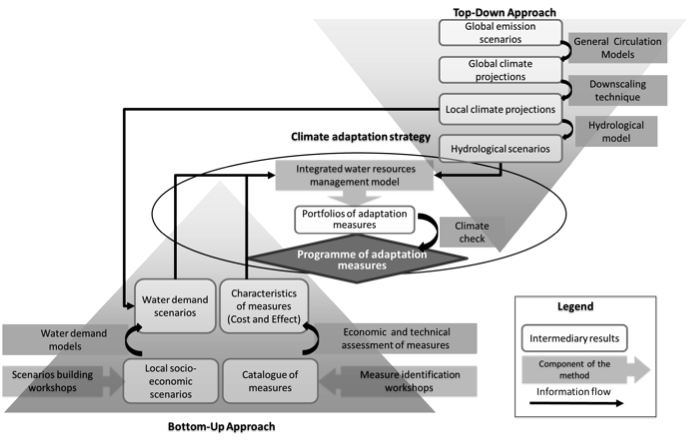Integrating top-down and bottom-up approaches to design global change adaptation at the river basin scale
LEAD ORGANIZATIONS
BRGM (French geological survey) and UPV (Universitat Politecnica de Valencia)
ORGANIZATIONS INVOLVED
Syndicat Mixte de la Vallée de l’Orb (SMVO); Office National de l’Eau et des Milieux Aquatiques (ONEMA)
Problem Statement
This project aims at integrating information from climate change projections, provided from a top-down modelling chain, with demand development scenarios and adaptation measures, obtain through a bottom-up approach, to define water management strategies to adapt to global change at the river basin scale.
Case Study
The high uncertainty associated with the effect of global change on water resource systems calls for a better combination of conventional top-down and bottom-up approaches, in order to design robust adaptation plans at the local scale. The methodological framework presented in this project introduces “bottom-up meets top-down” integrated approach to support the selection of adaptation measures at the river basin level by comprehensively integrating the goals of economic efficiency, social acceptability, environmental sustainability and adaptation robustness. The top-down approach relies on the use of a chain of models to assess the impact of global change on water resources and its adaptive management over a range of climate projections. Future demand scenarios and locally prioritised adaptation measures are identified following a bottom-up approach through a participatory process with the relevant stakeholders and experts. The optimal combinations of adaptation measures are then selected using a hydro-economic model at basin scale for each climate projection. The resulting adaptation portfolios are, finally, climate checked to define a robust least-regret programme of measures based on trade-offs between adaptation costs and the reliability of supply for agricultural demands.
This innovative approach has been applied to a Mediterranean basin, the Orb river basin (France). Mid-term climate projections, downscaled from 9 General Climate Models, are used to assess the uncertainty associated with climate projections. Demand evolution scenarios are developed to project agricultural and urban water demands on the 2030 time horizon. The results derived from the integration of the bottom-up and top-down approaches illustrate the sensitivity of the adaptation strategies to the climate projections, and provide an assessment of the trade-offs between the performance of the water resource system and the cost of the adaptation plan to inform local decision-making. The research contributes new methodological elements for the development of an integrated framework for decision-making under climate change uncertainty, advocating an interdisciplinary approach that bridges the gap between bottom-up and top-down approaches.

Combining Top-Down and Bottom-Up approaches to support the design of climate change adaptation programme of measures
Key Concepts
In the case study presented, adaptation measures, either supply or demand side management measures, are selected to ensure that the level of reliability (performance indicator) on the supply of urban and agricultural water demands and environmental flow are maintained under various scenarios of climate change and demand change, thus improving the performance of the current system under changing climate conditions.
Various programmes of adaptation measures defined in the case study, as a part of the adaptation strategy, have been, then climate checked under various climate projections to identify robust adaptation options for the system in a least-regret analysis.
Outcomes
- Top-down and bottom-up approaches are combined to define water management strategies to adapt to global change at the river basin scale. Economic efficiency, social acceptability, environmental sustainability and climate robustness are taken into account in the integrated approach.
- Least-cost programme of adaptation measures are identified through integrated modelling and optimization, and their performances are assessed under various future climate projections.
- A regret analysis is performed to contribute elements for adaptation decision-making faced with uncertainties.
Lessons Learned
- From a scientific perspective, the use of an integrated framework, based on a river basin optimization model, can be recommended to improve the economic efficiency and robustness of adaptation to climate change.
- However, the development of models relies on experts, and a top-down development process could impede the operational active involvement of stakeholders and the associated benefits.
- This research illustrates how analysing adaptation to global change in river basin management requires bringing together multiple scientific disciplines (engineering, hydrology, economics, social sciences, environmental sciences, climate modelling, etc.), and binding them into a single framework, facilitated by integrated modelling.
- Thus, each approach (concept and tools) had to be adapted to fit into the overall framework and the water resources management model, seen as an end-point for research and integration, was a useful tool to harmonize the different perspectives.
PROJECT WEBSITE OR RESOURCES
KEY WORDS
Climate change, adaptation measures, river basin model, climate check, top-down, bottom-up
COUNTRIES OR REGIONS INVOLVED
France, Languedoc Roussillon region
KEY STAKEHOLDERS
Farmers’ representatives, local water board (Syndicat Mixte de la Vallée de l’Orb (SMVO)), urban water utilities, local and regional authorities, river basin authority
About the Knowledge Platform
The Knowledge Platform is designed to promote and showcase an emerging set of approaches to water resources management that address climate change and other uncertainties — increasing the use of "bottom-up approaches" through building capacity towards implementation, informing relevant parties, engaging in discussion, and creating new networks. This is an ongoing project of the Alliance for Global Water Adaptation (AGWA) funded by the World Bank Group.


